Vickers Wellington, Waterford, February 1943
The foreign aircraft landing in Ireland that occurred on the
17th February 1943 stands out as being the last onethat resulted
in the internment of an Allied crew.
On the evening of 16th February 1943 RAF Bomber crews across
England prepared for a raid on the German U-boat pen base in the
French City of Lorient.
At the base of Royal Canadian Air Force 427 Squadron, nine crews
prepared for the raid, including one manned by men from England
and Scotland. The pilot, Sergeant Holloway took off at
18:27 hours and made a successful attack on the target. On the
return home however, things started to go wrong.
The ORB describes the raid as: Nine
aircraft were detailed to bomb the submarine base at
Lorient. All aircraft successfully bombed the
target. Sgt. Holloway and his crew landed in Southern
Ireland, safe and uninjured with the exception of Sgt.
Taylor who was very slightly injured. The attack
generally on Lorient was very successful.
The detail of Work carried out or Form 541 records their
mission as:
Target - LORIENT - Bomb Load - 3 x 500lb., 8 x 30lb, Inc.
and 425 x 4lb, Inc (25% "X" type). nothing has been
heard of this aircraft. Further news that this
aircraft landed in Ireland. Aircraft may have to be
burned. Crew interned.
Later that morning, an aircraft made a forced landing on the outskirts of Waterford town at a place known as the Sixcrossroads, due to it, unsurprisingly, being the meeting point of six roads. An aircraft had been observed at 0020 hours that morning by Coastwaterchers at Look Out Post (LOP) No. 15 at Forlorn Point and by Gardai in Tramore, to the east of Waterford. The watchers at Carnsore Point, LOP No. 14 next observed an aircraft flying north west three miles off to the north of the post.
Sgt Holloway, after seven hours in the air finally decided to
put the aircraft down, on its wheels in a field, which initially
happened smoothly, ended in the damaging of the aircraft when
its landing gear collapsed and a wing hit a tree. Sgt
Thomas was thrown out of the rear turret exit panel and Sgt
Taylor incurred some head injuries. Having evacuated the
aircraft, the crew activated a self destruction device on the
aircraft resulting in the fuselage and wings being completely
burned away. The description of the aircraft's landing
appears to have been from testimony provided to P J Cummins by
Sgt Slater in the 1980's or 1990's. He recalled that a
crowd approached the burning aircraft, and upon meeting the
crew, took them to the house of a family named Galvin where they
were rested and Sgt Taylor's injuries seen to.
It didn't take long for local Gardai and Local Defense Force
(LDF) members to arrive at the scene, guided by the glow of the
fire, and they cordoned off the burning wreckage. Just
after 2 a.m., a party from the 25th Infantry Battalion arrived
from Waterford Barracks and took the men with them back to the
city. They were taken that same day to the Curragh Camp in
Kildare and interned with the other Allied personnel there.
On the 18th February, Commandant D Mackey, the officer in
command of G2 branch, Intelligence, of the Curragh Command
submitted the following memo to the Headquarters, Army G2
Branch. Sometime later, personnel in Waterford Barracks
reported an aircraft circling the town with lights on.
Witnesses reported to researcher Patrick J Cummins that the
night was a clear moonlit night and the noise of the aircraft
roused people from their beds.
Chief Staff Officer,
G.2 Branch,
Department of Defence,
Dublin.
Sir,
I have the honour to
inform you that a British Wellington Bomber made a forced
landing 2 mls. E. of Waterford at 01.30 hrs. on the 17th
inst. The plane went on fire after crashing and was
destroyed except for the rear turret. The crew of five
Sergeants are safe and uninjured. They have been interned at
the Curragh since 21.45 hrs. same date.
Their names are:-
Sergt. John Holloway, 1288562,
235, Court Road, Ethane, London S.E.9,
Sergt. David Ross 1064822,
Glenlossie, Hermitage Drive, Edinborough.
Sergt. Frank Thomas, 1536438.
29, Regent St,, Earlstown, Newtown-Lee-Willows, Lancashire,
Sergt. George Slater, 1365352,
148, Mornlngton Rd., Edinborough. .
Sergt, Donald Taylor, 857301,
Rolyate, Lee Road, Lincoln.
The crew were not in possession of
identity cards and only one carried his identity discs. Each
N.C.O. carried a small waterproof packet which was sealed
and contains bank notes (French, Belgium and Holland) a
small compass and a piece of rubber inside of which was
embedded a small hacksaw. I am forwarding these five packets
to you herewith. I am also sending you the remains of a
burnt map of England but beyond that there were no papers or
documents which survived the flames. A map is also enclosed
in each packet.
It would appear that having completed
a bombing raid on San Nazaire (France) and while returning
to England the instruments, as the pilot, Sergt. Holloway,
said “went haywire’ and he lost his direction. He cruised
around for about an hour and petrol running low decided to
crash land. But for striking a tree with his starboard wing
he would have done this successfully and the plane would
have sustained little damage.
An officer from the Air Corps removed
the guns from the rear turret and also the wireless set from
the plane yesterday. Other parts can also be salvaged
including, I believe, one engine complete.
On my way to the scene of the crash
last evening I saw hundreds of civilians and children with
scraps of the plane as souvenirs going towards Waterford and
in the actual field found them removing parts. Capt. J
Fitzsimmons was in charge of the guard and a Garda was also
present but they didn't seem to appreciate that this was
wrong and I myself stopped a man from screwing off a part
from the rear turret under Capt. Fitzsimmons nose. I
immediately had the whole field cleared and Comdt. Martin
who was present when I left assured me that no one else
would be allowed into the field. In all such crashes
complaints about the same things are arising and officers do
not seem to realise their duties in connection with them.
The Command Engineer has been
instructed to help the Air Corps in the salvaging of the
remains and the O.C. Air Corps informed me that he is
sending a party to Waterford tomorrow.
The Irish Air Corps sent a team from Baldonnel on the 19th February and they took away the small amount of wreckage including one whole engine and the rear turret.
The five crew members then began their fourteen months of
internment in Ireland. They were first interned in the
Curragh Camp outside Newbridge in County Kildare.
At least four of the five were present at the wedding of fellow
internee Roswell F Tees of the RCAF on 14 Sep 1943, just prior
to the movement of the Allied Internees to the new camp at
Gormanstown in County Meath. A wedding photo was annotated
for publication in the book Grounded In Eire. The four
names recorded on that source are these:

On the 18 October 1943, the Allied internees were split into two
groups. The crew of Z1676 were placed in the group of
internees who were to be retained and moved to new accommodation
at Gormanstown. This move stemmed from a series of
negotiations conducted by the British Representative Sir John
Maffey with the Irish leader Eamon De Valera. As quoted in
UK National Archives report AIR35/2111:
The plan arranged is that the internees
are all to be removed to a new camp in the course of the
next few weeks, but those who can be regarded as having been
engaged on "non-operational" flying at the time of the crash
which led to their internment are being released in the
course of the transfer.
Details of the five men are given below. They appear to
have arrived on the Squadron in February 1943, and being an all
NCO crew their arrival in the Squadron is not recorded by name
or in detail.
Prior to the night they ended up in Ireland, Thomas and Slater
are found flying missions with two separate crews during
February but overall they had limited operational experience of
combat. They flew one sea mine laying sortie on the 12th
February to the coast of northern Holland.
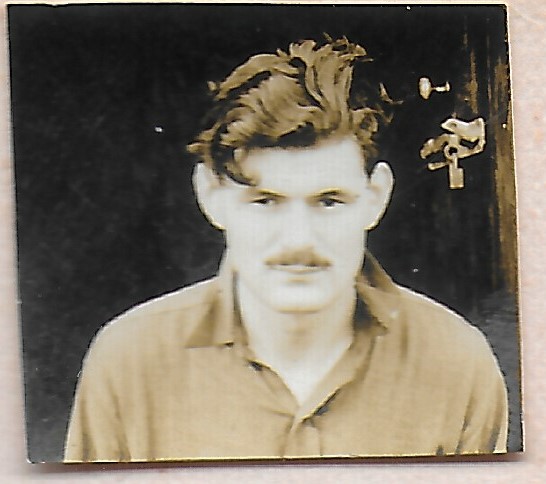 Sgt
John Edward HOLLOWAY 1266562, the pilot of Z1676, was
born on 21 Feb 1921 to parents, Robert John and Evelyn (nee
Snelgrove), in Bromley. His wife, Mrs Pearl Violet
Holloway, and parents wartime address was 235 Court Road,
Eltham, Sidcup. He had joined the RAF in September 1940
and later trained at No. 20 O.T.U. he appears to have
arrived at 427 Squadron in January or February 1943, flying his
first mission as a second pilot in February 4th.
Sgt
John Edward HOLLOWAY 1266562, the pilot of Z1676, was
born on 21 Feb 1921 to parents, Robert John and Evelyn (nee
Snelgrove), in Bromley. His wife, Mrs Pearl Violet
Holloway, and parents wartime address was 235 Court Road,
Eltham, Sidcup. He had joined the RAF in September 1940
and later trained at No. 20 O.T.U. he appears to have
arrived at 427 Squadron in January or February 1943, flying his
first mission as a second pilot in February 4th.
In his MI9 Escape and Evasion Report he only recorded:
My experiences are the same as related by F/Sgt. SLATER in
his report.
Attempted Escape: I was
concerned in the tunnel attempt started in Dec '43 which has
been described by P/O Tisdall in his report
(I.S.9(W)/REP/E/25).
P/O Tisdall in this case was a Royal Canadian Air Force internee from an earlier 1941 aircraft loss. He describes the attempt as follows:
Tunnel Scheme: In Dec 43 we
started a tunnel at Gormanstown. The opening to the
tunnel was under our sleeping quarters. The hut in
which we slept was built on a low concrete wall, and we
managed to make an opening in one of the unoccupied cubicles
and work down and then towards the wire.
Late in Apr 44 the camp authorities
had a raid and stopped the tunnel. They told us they
had known for some time that we were working at it.
John's wife Pearl is mentioned in a wartime index of internees
as John's wife, but is is unclear as to when they were
married. 1947 electoral registers find John and Pearl
living at 131 Eglinton Hill with her parents, Violet and Alfred
Hardy, an address he used on his 1944 escape and evasion
report.
John died on the 17 August 2011 in Kidlington, Oxfordshire.
Sgt David Eric Munroe ROSS 1064622 (Int) – David was
born in 1920 in the Morningside area of Edinburgh, Scotland.
Broke his ankle playing Rugby in March 1944 and was transferred
to Northern Ireland. His next of kin was his father, Mr A
Ross of Glenlosssie, Hermitage Drive, Edinburgh. He married his
wife, Dorothy M W Hallam in 1945 in Lancashire.
David died on December 26th, 2000 and this was advised by his
son Nigel Ross who himself died in December 2004, a year after
making contact with the website. Nigel passed on his
recollection of his father's wartime exploits:
One of my colleagues in our Belfast
branch sent me details of your web page this morning as I
had told him that as I was coming over to Cork for a few
days holiday and that whilst I was there I was going
to see if their was any information about the Wellington,
flown by my father which crash landed near Cork in either
1941/ 42. Your web page turned up three, one in
Donegal, too far North, one in Clare, too far West, and the
last near Cork in September 1942.
If this was the right one, it had been ambushed by two
night fighters ,having taken off from RAF Middleton St
George , now Tees -Side Airport to attack a submarine pen at
Lorient on the West coast of France, the resultant
damage being that one engine had had to be feathered , the
other eventually had caught fire, but more importantly , and
the reason it ended up in Southern Ireland as opposed to
England, that large chunks of the tailplane had been shot
away and it was jammed to port which made it very
difficult to control. or steer.
As none of the crew fancied going down in the
sea, when the lights of Ireland appeared on the
horizon a solution to the problem appeared at hand but
all of this was of no importance when the aircraft
collided with some power cables and was brought down
apparently near the town of Cork.
All of the crew escaped , with a variety of non life
threatening injuries , which in itself was remarkable as the
fuselage had by then caught fire and tracer bullets from the
burning front gun turret were spraying into the air, two of
them going through my fathers right leg. and causing him to
end up in the local
hospital before he was
taken away to be interned.
Nigel continued his fathers story
After he was discharged from hospital
he ended up in Corks local prison for a while, and was then
shipped up to a dispersal point near Dublin which turned out
to be the Curragh.
From there, because I suspect that the Irish Government
didn't know what to do with him, and the rest of their
"guests" he was sent to study at Trinity College doing , I
suppose the then equivalent of a business studies course.
I think he did this for a couple of terms but then he
decided to get back home, an idea, supported by my
grandmother , who came across from Edinburgh , every two
months or so to see him and eventually did so, being carried
over the border, in a coffin, with a bottle of Bushmills for
company.
On his return he resumed flying from a variety of bases
round England and in a variety of planes.
Eventually he ended up flying Mosquitos from RAF Upper
Heyford in Oxfordshire which at that time was shared by a
couple of American P51 units and whilst there played the
piano at two concerts given by Glenn Miller and his band ,
who's own pianist was ill.
He had at that time, also married my mother , who was
billeted in a cottage near the end of the runway and
which apparently he used to beat up when he came back from a
mission.
Awaiting demob , his final posting was to RAF Millom in
Cumberland , where as you might imagine there wasn't a lot
going on. One thing however did lighten up the boredom when
he was told to take a launch and a crew armed with a
couple of machine guns across to Northern Ireland and when
he arrived was to pick up , from Shorts three brand new
Sunderland Flying boats, tow them out to the middle if the
Irish sea , and sink them by firing into their fuselages.
After that , he was demobbed , went back to the family
business in Edinburgh.
had the occasional communication from some of the people he
had flown with, one of whom became a fairly well known tv
and film actor in the 60's early 70's, but whom I have not
heard of for years.
After my mother died , he had decided to write a book about
his exploits , and was planning to go back across to Cork,
and Dublin with my sister as a companion to relive
some memories and to try to locate a girl whom he had been
fond of, but none of this was to happen , as he died very
unexpectedly , on Boxing Day 2000 aged 80.
This testimony from his son is interesting for the number of
apparent inaccuracies it contains but is in common with similar
tales of escaping that other relatives of Allied internees told
people.
- It is of note that the date of the landing was unknown to
Nigel, and at the time he wrote, the website may not have listed
crew names, hence his assumption is as the Wellington at
Charleville.
- There is no mention of the Wellington Z1676 being damaged by
Luftwaffe aircraft in the records from the Irish Army, nothing
in the crew members escape and evasion reports or in the
testimony of George Slator to P J Cummins.
- There is no mention of any of the crew members being injured,
let alone shot through the leg. All members of the crew
were brought to the Curragh the same day as the crash.
- And he certainly didn't escape in a coffin with whiskey for
comfort! He was moved to the new camp at Gormanstown, and
there got injured playing rugby.
Sgt Donald Hugh TAYLOR 657301 was born on 3rd July 1916, the son of Richard and Mabel Taylor. He gave the Irish army his address as 28 Geneva Cresent, Darlington, Durham. His father is recorded as being Richard E Taylor at Rolyat, 26 Lee Road, Lincoln, Lincs.
He trained as a Bomb Aimer, its seems after initially training
to become a pilot. In August 1941 he traveled to America
from Canada via Detroit to undertake training at Alabama Aero.
Inst. Tuscaloosa.
Donald in his escape and evasion report reveals his method of
escape, one that involved no small amount of subterfuge.
When we reached The CURRAGH in Feb
43 we were told that there had been several escape
attempts from the camp in 1942, ad that officers and O.R's
had been advised by our authorities to discontinue
such attempts.
About Mar 43 I conceived a plan of getting myself
repatriated. I feigned to have an obsession that I
was suffering with venereal disease. I insisted on being
examined by various doctors, six in all, including a
specialist in DUBLIN, (Dr. GILL). Although the
doctors tried to convince me, having carried out all possible
tests, that there was no sign of the disease, I pretended
still to retain the obsession, with a view to
bringing on a nervous breakdown.
In Oct 43 a number of officers and O.R's were
repatriated. The CURRAGH camp was cleared of all
British personnel, and we were moved to GORMANSTOWN Camp, County
MEATH, EIRE.
Shortly before Christmas I took up my obsession again,
this time claiming to have violent pains all over my
body.
I obtained permission from the Air Attache (Wing
Commander BEGG) to see the specialist in DUBLIN
again. Dr. GILL tried to convince me that there was nothing
the matter. I then started to feign a complete nervous
breakdown.
I locked myself into my room and went
without washing and shaving for days. I cut my meals
down to one a day, never went out, slept with the lights on,
ignored my fellow internees, and worked myself up to such a
pitch, that a psychiatrist was eventually sent to see me on
23 Jan 44.
The psychiatrist only spent about a quarter of an hour with
me, but the result was that two days later (25 Jan) I was
moved to Sir PATRICK DUNN's Hospital in DUBLIN, and on 27
Jan taken by Wing Commander BEGG over the border and handed
over to S/Ldr. GARDINER in BELFAST.
S/Ldr. GARDINER brought me to this country on 29 Jan.
He passed away in Manchester in October 1987.
Sgt George Chalmers SLATER 1365352 was born on 7
Dec 1921, Son of George Slater and Elizabeth Slater. – 20 O.T.U.
– Wireless Operator Mr G Slater [father] 145 Morningside Road,
Edinburgh Married April 1, 1955.
George died on the 8th April 2002 in Wick, Scotland.
His evasion report states: We took off from CROFT in a Wellington aircraft on 17 Feb 1943 at 1830 hrs on a bombing trip to Lorient. On the return journey to base it was not possible to get satisfactory loop bearings. We made landfall at 0030 hrs, 18 Feb, and crash-landed owing to shortage of petrol. We landed in a field near WATERFORD, Co. WATERFORD, EIRE. I was arrested by the police and interned in the CURRAGH Camp until 16 Oct and at GORMANSTOWN until 15 July 44, when I was sent to the UK.
His family were able to supply a series of photos that George
kept from his time in Ireland. It is thought that these
photos were taken in the later Gormanstown Camp as those in the
photos seem to only be from that batch of airmen.
The photos below show Sgt Slater stood next to a set of tall
steps.
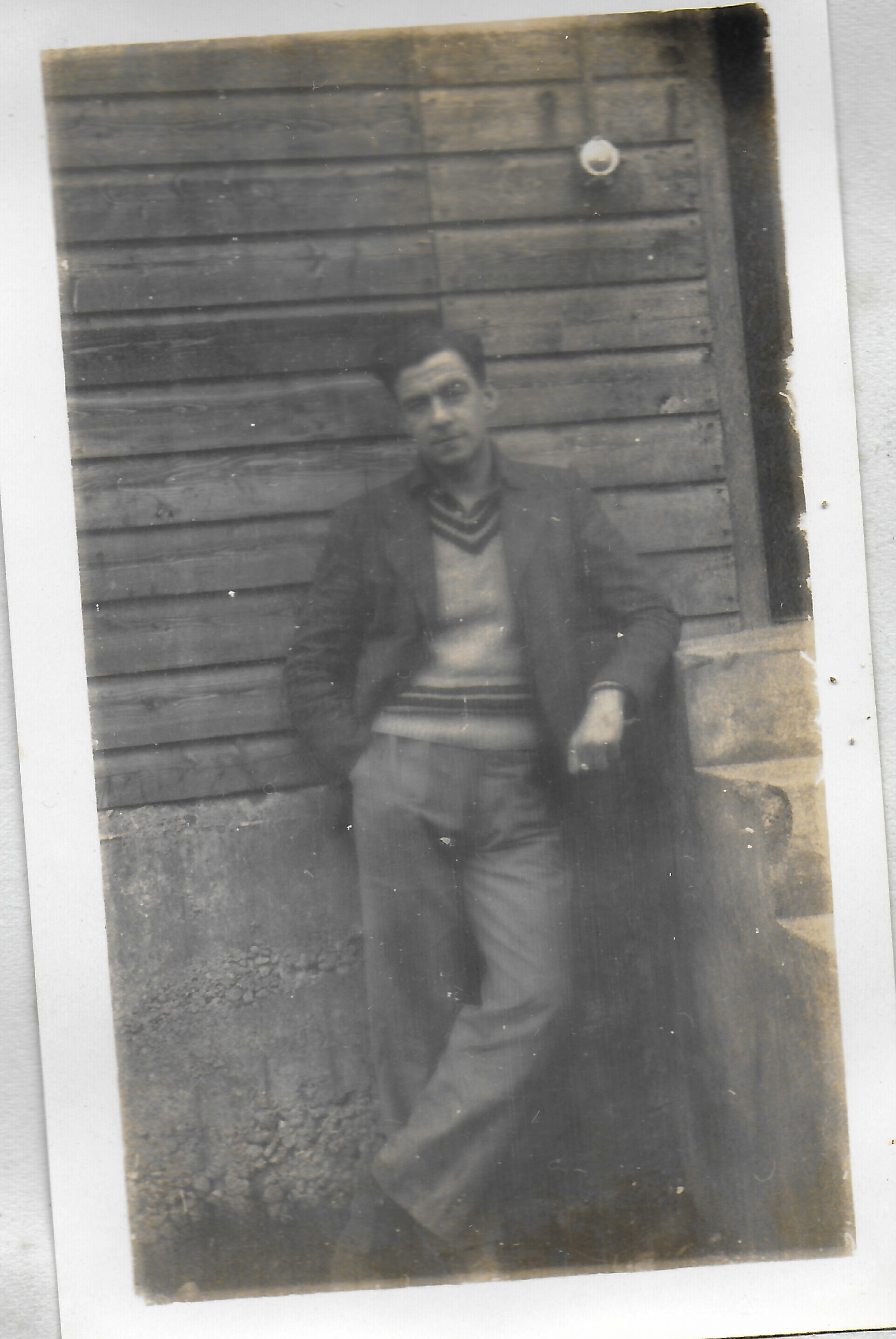
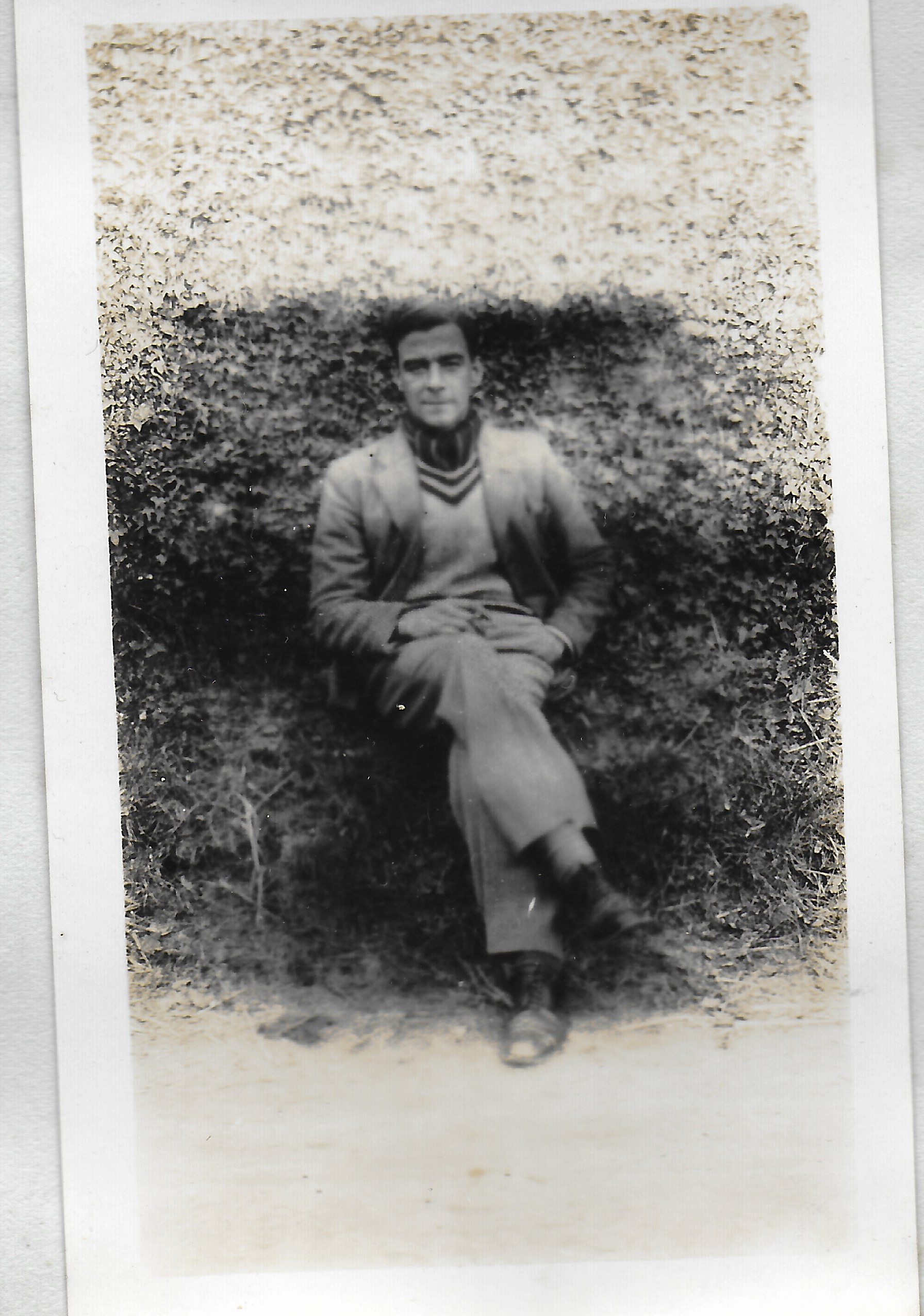
Sgt Frank THOMAS 1536438 was born on 31st August 1921,
the son of Nathanial and Alice Thomas. The 1939 register
finds him resident with his mother at 29 Regent Street,
Newton-Le-Willows, Lancashire and undertaking an electricians
apprenticeship. He trained as Air Gunner and also found
himself at 20 OTU.
Sgt Thomas provided the most detailed version of events in his
evasion report, describing his time in Ireland as follows:
I took off from CROFT (Co. Durham)
about 1800 hrs on 16 Feb 43 in a Wellington aircraft to bomb
Lorient.
We reached our target and set a course
for home. About fifteen minutes after our expected
time of arrival we sent out an S.O.S. asking for our
location. We continued to do this for about two hours,
but, except for one occasion when we received a signal that
was two feint to follow, we did not receive a reply.
About 0100 hrs (17 Feb) when we were
about to ditch the aircraft because of lack of petrol we saw
some lights in the distance. We made towards these and
landed with wheels down hoping that we might be able to
refuel and take off again. Unfortunately, we hit a
tree on landing. I was thrown out of the aircraft and
the plane was set on fire.
Before we came down the wireless
operator had destroyed all secret equipment.
I think that three of our
escape boxes were burned in the aircraft. The
remaining box and, I believe, the purses were sent to the
Air Attache, DUBLIN
Frank Thomas passed away in Newton-Le-Willows in October 2000.
Some of the men appear in two group photos from the Slater
set. By comparing with the Tee's wedding photo and some
other photos, the photos below seem to show the following
personnel:
Top Step, left to right: Reid, Diaper, Wakelin
Front row, Newby and Thomas
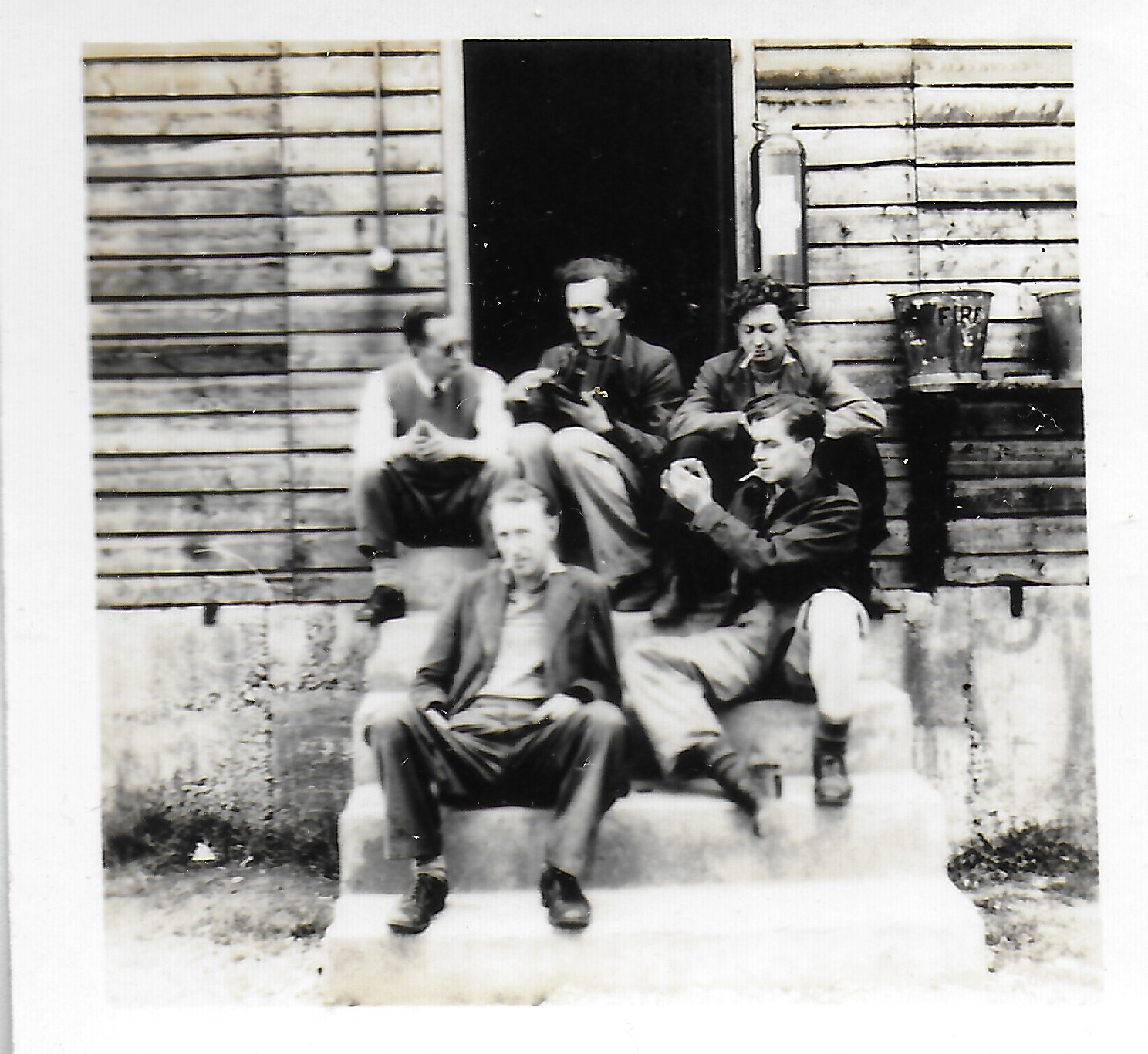
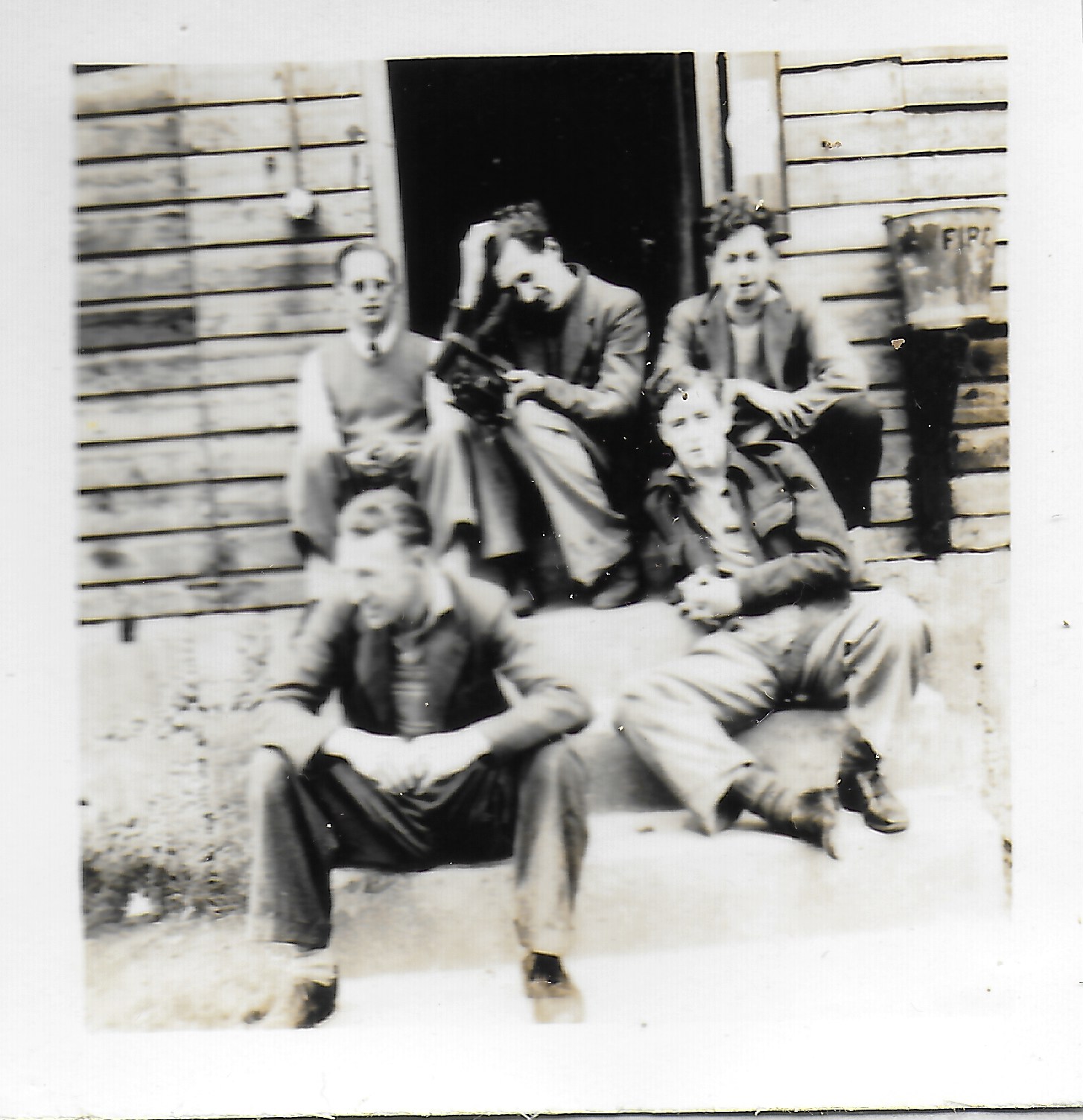
In addition to those, it appears that at least three of the
internees, two from this crew, were members of Drogheda Rugby
Football Club during the 1943-44 season. The side image is
that of a D E M Ross, G C Slater is named at the front right and
the man at the rear left hand side is D Reid who was from the
crew of Hampden AD768.
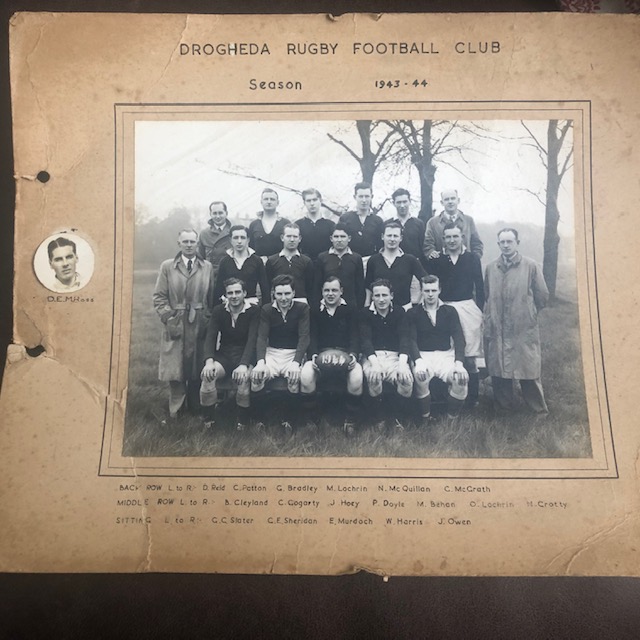
Compiled by Dennis Burke, July 2020, Dublin and Sligo.
If you have information on any of the people listed above, please do contact me at dp_burke@yahoo.com
